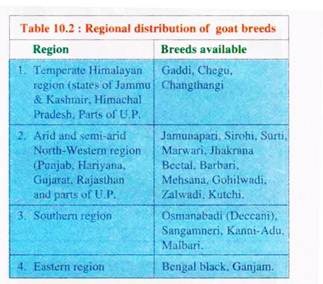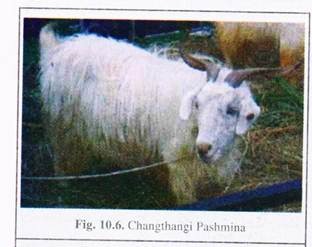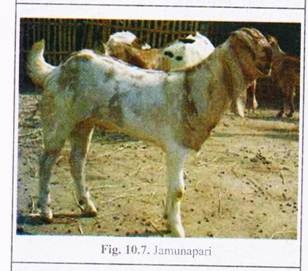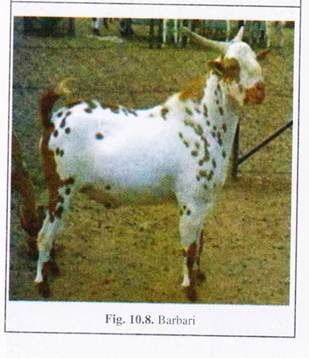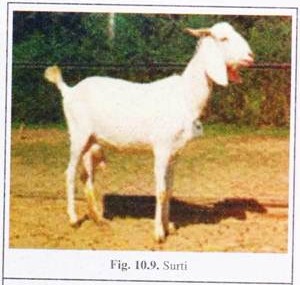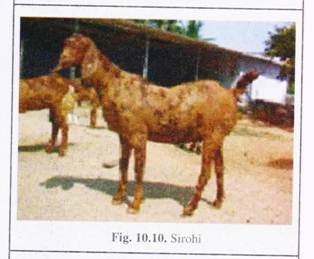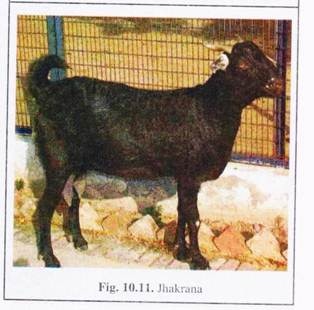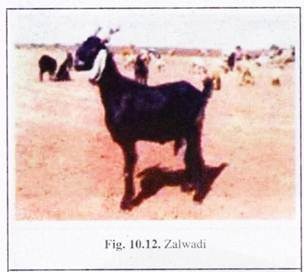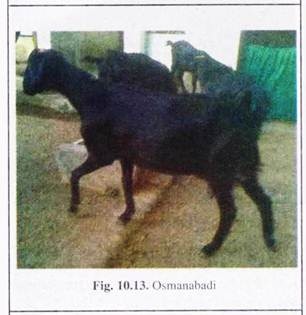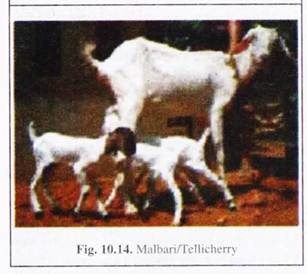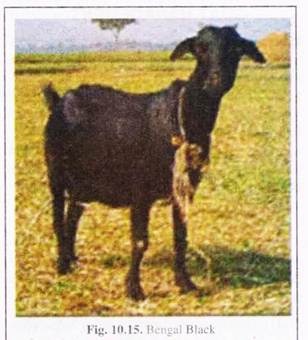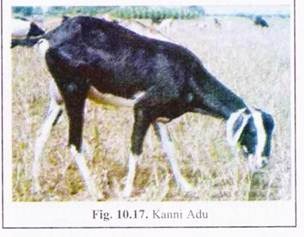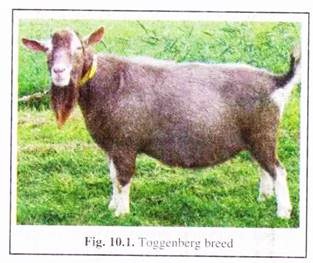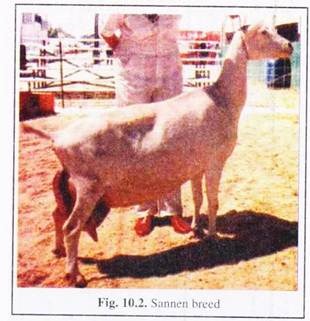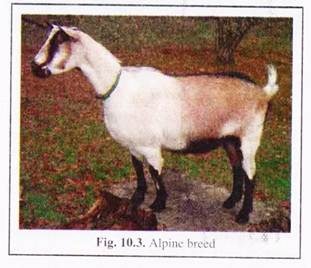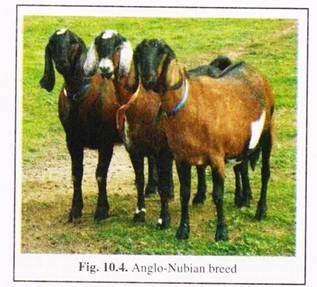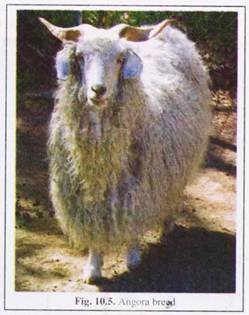In this article we will discuss about the indigenous and exotic breeds of goat found in India.
Indigenous Goat Breeds:
In India, each goat breed is considered as a population living in a given locality with a local name and having characters distinct from other such population. At present, in India four agro-climatic regions are known to have the following goat breeds (Table 10.2).
Description, uses and distribution of the above mentioned breeds are presented below:
1. Gaddi/Himalayan:
ADVERTISEMENTS:
Distribution:
Kangra and Kulu valleys, Ladakh; Girmul and Simla and parts of Jammu.
Description:
Average body weight of male is 27 kg and female is 25 kg. Sturdily built medium sized body covered by coats which are mostly white, but black and brown combinations are also seen. Coarse, long hair measure about 8-10 inches. In both sexes, horns are large, upward and directed backwardly. Tapering muzzle and ears are long, pointed and drooping.
ADVERTISEMENTS:
Uses:
(1) Castrated bucks are used for transport.
(2) Good for hair, average fleece yield is about 300 gm/clip.
(3) Can also be used for meat.
2. Chegu:
ADVERTISEMENTS:
Distribution:
Mountaneous range of Spiti of HP, Yaksar and Kashmir of J &K, Uttar Kashi, Chamboli and Pithoragarh of U.P., etc.
Description:
Average body weight of male is 36 kg whereas that of female is 25 kg. Medium sized goat with body colour white and also mixed with greyish red. Both sexes have prominent horns, upward and directed backward with one or few twists. Hair length is about 5-9 cm.
Uses:
(1) This breed is used mainly for pashmina production: average yield is 120 gm/year.
(2) Small quantity of milk and good meat can also be obtained.
3. Changthangi Pashmina (Fig. 10.6):
Distribution:
Ladakh, Lahaul valley of J & K. Spiti of Uttarakhand.
ADVERTISEMENTS:
Description:
Small to medium sized body. Adult males weigh 20 kg and females weigh about 19 kg. These goats are mostly white, but black, grey or brown are also seen. Horns in both sexes are large, turning up and outwardly to form semi-circle with some variations both in size and shape.
Ears are long and usually pendulous.
Uses:
(1) This breed produces long fine pashmina on both sides of body and shoulder. Average production of pashmina is 70-500 gm/animal/year. This pashmina is used to prepare Kashmir shawl or rug.
(2) In hilly areas, used for transportation.
4. Jamunapari (Fig. 10.7):
Distribution:
Mostly found in Etawah district of U.P, and in tracts lying between Jamuna, Ganges and Chambal rivers.
Description:
Most majestic and biggest goat breed of India. Large sized, tall body with average body weight in male 50-60 kg and in female 40-50 kg. Body colour mostly white or light yellowish tan with light brown spots on neck and face and occasionally black or tan patches are found on body. Most characteristic feature of this breed is highly convex nose line with a tuft of hair, known as “Roman nose” or parrot mouth appearance.
Horns are medium sized and curved outwardly. Ears long, flat and dropping. A thick patches of hair are present on buttock region.
Uses:
(1) This breed is famous for dual purposes — milk and meat. Average milk yield varies from 1.5 to 2 kg/day.
(2) Meat quantity is good with a bone and meat ratio of 1: 3.9.
(3) Usually doe kids once a year.
(4) This breed has been extensively used to upgrade indigenous breeds for milk and meat.
5. Barbari (Fig. 10.8):
Distribution:
In U.P, Etawah, Agra, Mathura and Aligarh districts. Gurgaon, Karnal, Panipat and Rohtak in Haryana.
Description:
Small goats with compact body weighing 40 kg in male and about 24 kg in female. Body colour varies, white with light brown pathces is most common. Both sexes have horns that are twisted and directed upward and backward. Ears are short, tubular and erect. Bucks bear thick long beard.
Uses:
(1) This breed has dual purposes of milk and meat. Milk yield is 130-200 kg in a lactation period of 150 days.
(2) Barbari is a prolific breeder, kids twice in a year and generally gives birth twin or triplets.
(3) Its dwarf size and habit of stall feeding made it suitable for city rearing where grazing facilities are rare.
6. Beetal:
Distribution:
Throughout the state of Punjab and Haryana
Description:
Large breed; body weight in male is 50-62 kg and in female is 35-40 kg. Body colour varies with white, red and tan spots being common. Roman nose, long dropping ears and small thin tail are the characteristics of beetal breed. Both sexes have horns which are directed backward and have few twists. Only male possesses beard.
Uses:
(1) Reared mainly for milk. Yield per lactation varies from 150-190 kg.
(2) Highly adaptable to various agroclimatic zones.
(3) Kidding is good.
7. Surti (Fig. 10.9)
Distribution:
Surat and Baroda districts of Gujarat.
Description:
Average body weight is 30 kg in male and 32 kg in female. Medium sized body is white in colour. Both sexes have small horns directed backward. Females with highly developed udder.
Uses:
(1) This breed is a good milk producer; yielding on an average 2.0 kg/day.
(2) Very suitable for rearing under confinement as this goat can live on food waste and leaves.
8. Sirohi (Fig. 10.10):
Distribution:
Sirohi district of Rajasthan and Palampur in Gujarat.
Description:
Compact medium sized goat (body weight is 50 kg in male and 40 kg in female). Coat colour generally brown with light/dark brown patches. Hair short and coarse. Both sexes have small horn, curved backward. Ears flat and dropping.
Uses:
(1) Sirohi is a choiceable goat breed for meat.
(2) Milk yield is relatively small, about 0.5 kg/day.
(3) It is well suited to stall feeding.
9. Marwari:
Distribution:
Marwar regions of Rajasthan
Description:
This medium size goat breed is predominantly jet black in colour. Body weight of male is 33 kg and that of female is 25 kg on an average. Both sexes have short pointed horns, directed upward and backward. Ears are small and flat. Males have thick beard.
Uses:
(1) Marwari doe is a poor milk yielder, about 0.8 kg/day.
(2) It is good for meat.
(3) Lustrous hair can be used for different purposes.
10. Mehsana:
Distribution:
Found in Mehsana, Gandhi Nagar and Ahmedabad districts of Gujarat.
Description:
Mehsana is larger than Marwari breed with an average body weight of 36 kg in male and 32 kg in female. Black body is covered by long coarse hair with white spot at the base of ear. Ears are always white. Horns in both sexes are twisted & curved upward & backward.
Uses:
(1) Triple purpose use for milk, meat and hair.
(2) Milk yield averages 1.0 kg/day.
(3) Average hair yield is 200 gm/goat/year
11. Jhakrana (Fig. 10.11):
Distribution:
Alwar district of Rajasthan
Description:
Large goat breed; males weigh about 55 kg and females about 45 kg. Black body with white spots on ears and muzzle. Fare head is slightly bulging.
Uses:
(1) Good milk yielder. Average milk production varies 2-3 kg/day.
(2) Prolific breeder. Twins and even triplets are common.
(3) Its meat is also popular.
(4) Skin is used in tanning industry.
12. Kutchi (Kathiawari):
Distribution:
Kutch district of Gujarat and few places of Rajasthan.
Description:
Large breed with medium body weight (male: 42-45 kg, female: 30-40 kg). Body colour predominantly black but may be white, brown or even spotted. Hair long, nose slightly ‘Roman’ type, and ears are long, broad and dropping. Cork screw horns pointed upward.
Uses:
(1) Milk yield is around 1.5 kg/day.
(2) About 500 gm hair can be obtained /goat if shorn twice a year.
(3) Kutchi also acceptable for meat.
13. Zalwadi (Fig. 10.12):
Distribution:
Zalwad regions of Gujarat
Description:
Body is large; black in colour with white ears. Male weighs about 38 kg and female about 32 kg. Both sexes have long twisted horns, pointed upward. Ears are large leaf-like and dropping.
Uses:
(1) This breed is reared mainly for meat.
(2) Daily milk yield is about 1.5 kg.
(3) Hair can be used for different purposes.
14. Gohilvvadi:
Distribution:
Bhavnagar, Amreli and Junagarh districts of Gujarat.
Description:
This is also a large goat breed. Body weight of adult male averages 37 kg and female averages 36 kg. Black coat is covered with long hair. Nose is slightly convex. Ears are tubular and dropping. Both sexes have slightly twisted horns, turned backward.
Uses:
(1) Gohilwadi is useful for milk yield, average daily milk yield is 1.7 kg for a total lactation period of 228 days.
(2) Their hair is used for different purposes.
15. Osmanabadi (Fig. 10.13):
Distribution:
Osmanabad region of Maharashtra and adjoining areas.
Description:
Average body weight in male is 34 kg and that of female is 32 kg. Coat colour varies, but mostly black; mixture of white and black or red are also found. All males and 50% of females are horned. Ears are of medium sized.
Uses:
(1) Not so popular for milk; average milk yield varies from 0.5 to 1.5 kg during a lactation period of about 4 months.
(2) This breed is mainly reared for meat.
(3) The does can breed twice in a year and twinning is common.
16. Malbari/ Tellicherry (Fig. 10.14):
Distribution:
Northern Kearla including Calicut. Cannore and Mallapuram Districts.
Description:
Medium sized breed where males are usually of 38 kg and females vary between 30-32 kg. Coat colour highly variable from complete white to full black. Head with flat and occasional Roman nose, small twisted horns and medium sized ears. All males and some females are bearded.
Uses:
(1) Malbari is mainly reared for meat.
(2) They are poor milkers.
(3) Skin is useful for tanning industry.
17. Sangamneri:
Distribution:
Pune and Ahmednagar districts of Maharashtra.
Description:
It is also a medium sized breed with average body weight like that of Malbari goats. No uniform body colour; it varies from white to black/brown with spots of other colours. Both sexes are horned. Ears are dropping.
Uses:
(1) Not reared for milk.
(2) Meat production is good.
(3) Dressing percentage is about 41 at 6 months, 45 at 9 months and 48 at 12 months of ages.
18. Bengal (Bengal Black) (Fig. 10.15):
Distribution:
West Bengal, Bihar, Orissa.
Description:
Goats are small sized; adult male body weight is about 30-32 kg and that of female is about 20 kg. Predominant body colour is black, but may be white, grey etc. Body is covered with soft and short hair. Shoulder and hips are of equal height, chest is wide. Both sexes have small to medium sized horns directed upward and sometimes backward. Ears are upright and pointed. Beard is found in both sexes.
Uses:
(1) This breed is reared for excellent meat. Dressing percentage is around 48%.
(2) Skin is also of superior quality and has great demand in footwear industry.
(3) Does kid twice in a year; multiple birth is very common.
(4) Not a good milker.
19. Ganjam (Fig. 10.16):
Distribution:
Ganjam and Koraput districts of Orissa
Description:
Tall goat breed where males are about 45 kg in body weight and females are about 31 kg. Body colour varies, black is predominant but white, brown or spotted are also available. Hairs are short and lustrous. Horns in both sexes are long and straight.
Uses:
(1) Prolific breeder; litter size 1.8 kids.
(2) Mainly raised for meat and is poor milker.
20. Kanni-Adu (Fig. 10.17):
Distribution:
Tamil Nadu
Description:
Tall goat with a body weight of 34-38 kg in male and 28 kg in female. Predominantly black body with white spots. Ears are: medium in length. Males are horned and females are pooled.
Uses:
(1) Very important meat goat.
Exotic Goat Breeds:
The principal exotic dairy breeds of goats are Toggenberg, Sannen, French Alpine and Nubian. They are all noted for their higher milk yield and most of these breeds were imported to India to improve milk yield of our local breeds and to upgrade our non-descript goats.
1. Toggenberg:
It is originated in the Toggenberg valley in north Switzerland. Skin is very soft and pliable. Usually both male and female are hornless (Fig. 10.1). The adult doe weights 65 kg or more and the bucks more than 80 kg. Average milk production is 5.5 kg per day. The butterfat content of its milk is 3-4 per cent. The male usually has longer hair than the female.
2. Sannen:
It is a native of Sannen valley of Switzerland and is noted for its consistency and high production of milk. Does weigh 65 kg and the bucks 95 kg. Colour is white or light cream. The face may be slightly dished and the ears point upward and forward (Fig. 10.2). Both sexes are normally polled but sometimes horns do appear. Average milk yield is 2-5 kg per day during a lactation period of 8-10 months. Milk fat is 3-5%.
3. Alpine:
This breed was originated in Alps mountains. It was derived from French, Swiss and Rock Alpine breeds. They are horned and have no distinct colour. Average milk yield is 2-3 kg with butterfat of 3-4% (Fig. 10.3).
4. Nubian:
Originated in Nubia of north-eastern Africa. Also found in Ethiopia and Egypt. It is a long legged and hardy animal. The breed along with Jamunapari of India together with native breeds of U.K. formed the Anglo Nubian breed of goat.
5. Anglo Nubian:
It is a big animal with a fine skin and glossy coat, pendulous ears and Roman nose. Anglo Nubian is known as the Jersey cow of the goat world. Udder is large and pendulous with bigger teats. There is no fixed colour. Bucks weigh 65-80 kg and does from 50-60 kg. Average milk yield is 3-4 kg/day. Peak yield may even go up to 6.5 kg or more (Fig. 10.4).
6. Angora:
Originated in Turkey or Asia minor. It produces a superior quality fibre, called mohair. The soft silky hairs cover the white body. If not shorn during spring the fleece drops off naturally as summer approaches. Average fleece yield is 1.2 kg. Good animals yields even up to 6 kg. The angora is small in size with shorter legs. Horns are grey, spirally twisted and inclined backward and outward. Tail is short and erect (Fig. 10.5).
